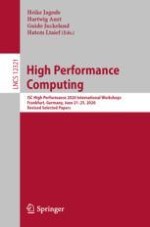This book constitutes the refereed post-conference proceedings of 10 workshops held at the 35th International ISC High Performance 2020 Conference, in Frankfurt, Germany, in June 2020:
First Workshop on Compiler-assisted Correctness Checking and Performance Optimization for HPC (C3PO); First International Workshop on the Application of Machine Learning Techniques to Computational Fluid Dynamics Simulations and Analysis (CFDML); HPC I/O in the Data Center Workshop (HPC-IODC); First Workshop \Machine Learning on HPC Systems" (MLHPCS); First International Workshop on Monitoring and Data Analytics (MODA); 15th Workshop on Virtualization in High-Performance Cloud Computing (VHPC).
The 25 full papers included in this volume were carefully reviewed and selected. They cover all aspects of research, development, and application of large-scale, high performance experimental and commercial systems. Topics include high-performance computing (HPC), computer architecture and hardware, programming models, system software, performance analysis and modeling, compiler analysis and optimization techniques, software sustainability, scientific applications, deep learning.
